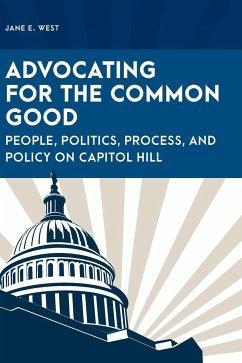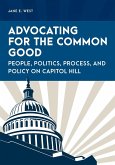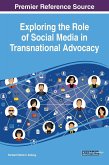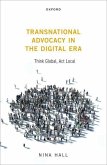- Gebundenes Buch
- Merkliste
- Auf die Merkliste
- Bewerten Bewerten
- Teilen
- Produkt teilen
- Produkterinnerung
- Produkterinnerung
Drawing on both the public policy scholarship and the daily practicalities on Capitol Hill, this book builds on the author's extensive federal policy experience as well as that of others to offer the information and tools needed to effectively participate in Washington D.C. policy-making. Rich and accessible, this book is a clear call for action.
Andere Kunden interessierten sich auch für
![Advocating for the Common Good Advocating for the Common Good]() Jane E. WestAdvocating for the Common Good32,99 €
Jane E. WestAdvocating for the Common Good32,99 €![The Abolition of the State: An Historical and Critical Sketch of the Parties Advocating Direct Government, a Federal Republic, Or Individualism The Abolition of the State: An Historical and Critical Sketch of the Parties Advocating Direct Government, a Federal Republic, Or Individualism]() Sigmund EngländerThe Abolition of the State: An Historical and Critical Sketch of the Parties Advocating Direct Government, a Federal Republic, Or Individualism29,99 €
Sigmund EngländerThe Abolition of the State: An Historical and Critical Sketch of the Parties Advocating Direct Government, a Federal Republic, Or Individualism29,99 €![Exploring the Role of Social Media in Transnational Advocacy Exploring the Role of Social Media in Transnational Advocacy]() Exploring the Role of Social Media in Transnational Advocacy179,99 €
Exploring the Role of Social Media in Transnational Advocacy179,99 €![Reenvisioning Peacebuilding and Conflict Resolution in Islam Reenvisioning Peacebuilding and Conflict Resolution in Islam]() Qamar-Ul HudaReenvisioning Peacebuilding and Conflict Resolution in Islam104,99 €
Qamar-Ul HudaReenvisioning Peacebuilding and Conflict Resolution in Islam104,99 €![Reenvisioning Peacebuilding and Conflict Resolution in Islam Reenvisioning Peacebuilding and Conflict Resolution in Islam]() Qamar Ul-HudaReenvisioning Peacebuilding and Conflict Resolution in Islam45,99 €
Qamar Ul-HudaReenvisioning Peacebuilding and Conflict Resolution in Islam45,99 €![Rhetoric in Human Rights Advocacy Rhetoric in Human Rights Advocacy]() Richard K GhereRhetoric in Human Rights Advocacy132,99 €
Richard K GhereRhetoric in Human Rights Advocacy132,99 €![Transnational Advocacy in the Digital Era Transnational Advocacy in the Digital Era]() Nina HallTransnational Advocacy in the Digital Era111,99 €
Nina HallTransnational Advocacy in the Digital Era111,99 €-
-
-
Drawing on both the public policy scholarship and the daily practicalities on Capitol Hill, this book builds on the author's extensive federal policy experience as well as that of others to offer the information and tools needed to effectively participate in Washington D.C. policy-making. Rich and accessible, this book is a clear call for action.
Produktdetails
- Produktdetails
- Verlag: Rowman & Littlefield Publishers
- Seitenzahl: 198
- Erscheinungstermin: 30. Mai 2023
- Englisch
- Abmessung: 260mm x 183mm x 15mm
- Gewicht: 578g
- ISBN-13: 9781538155226
- ISBN-10: 1538155222
- Artikelnr.: 67223409
- Herstellerkennzeichnung
- Libri GmbH
- Europaallee 1
- 36244 Bad Hersfeld
- gpsr@libri.de
- Verlag: Rowman & Littlefield Publishers
- Seitenzahl: 198
- Erscheinungstermin: 30. Mai 2023
- Englisch
- Abmessung: 260mm x 183mm x 15mm
- Gewicht: 578g
- ISBN-13: 9781538155226
- ISBN-10: 1538155222
- Artikelnr.: 67223409
- Herstellerkennzeichnung
- Libri GmbH
- Europaallee 1
- 36244 Bad Hersfeld
- gpsr@libri.de
Jane E. West
List of Tables, Textboxes, and Figures
Acknowledgments
Author's Note
Introduction
1 People
The Iron Triangle
Congress Congressional Staff and Congressional CommitteesRelationships Are
EverythingThe Executive BranchInterest GroupsProfessional and Trade
AssociationsBusiness or Corporation AssociationsPublic Interest GroupsThink
TanksWhat Do Interest Groups Do in Relation to Policy and
Advocacy?Political Action Committees and 501 (c) (4)s CoalitionsGovernment
Relations/Lobbying Firms LobbyingBeyond the Iron Triangle
The CourtsSocial Media and the PressPublic OpinionConstituentsGrass Roots
Movements and OrganizationsExperts The Culture of Policy Making vs. the
Cultures of Other Sectors
Representation Matters
Takeaways: People
2 Politics
Majorities and Minorities in Congress
Seniority in CongressThe White House
Election Cycles
Participating in Election Campaigns
Transition to Office after Winning an Election
Bipartisanship
Takeaways: Politics
3 Process
Part I: Summary of the Literature on Public Policy Making Processes
Framework #1: The Cyclical FrameworkProblem DefinitionAgenda SettingPolicy
FormulationPolicy AdoptionPolicy ImplementationPolicy Evaluation Framework
#2: Policy Streams Part II: Congressional Procedures
How a Bill Becomes a Law: The Seven Steps of Regular OrderBill
IntroductionThe Committee Receives the Bill Possible Referral to
SubcommitteeHearings and MarkupsFloor ConsiderationConference
CommitteePresident's SignatureThree Core Legislative Processes: Budget,
Appropriations, AuthorizationBudget Process ReconciliationDeeming
ResolutionsAppropriations ProcessMandatory and Discretionary
SpendingEarmarksAuthorization ProcessOther Congressional ProcessesOversight
and InvestigationsConfirmationsSenate and House RulesCommittee on Rules of
the House of RepresentativesFilibuster and Cloture in the SenatePart III:
Executive Branch Processes
Executive OrdersFederal Rule Making Before the Proposed RuleThe Proposed
RuleBefore the Final RuleThe Final Rule After the Final Rule Negotiated
Rule MakingOther Key Federal Agency Functions Related to Policy
MakingGuidance Takeaways: Process
4 Policy
Which Comes First: The Problem or the Solution?
Policy Tools
GrantsAppropriationsCivil RightsAccountabilityData CollectionEnforcement
MechanismsResearchIndividual BenefitsTax CodeRequirements Related to
Implementation by Federal AgencyWhat is Good Policy?
The Americans with Disabilities Act and the Use of Standardized Assessments
in Federal Education Policy: Point/Counterpoint The ADA: A Remarkable
PolicyNCLB and Its Derivatives: The Use of Standardized Assessments in
Federal Education Policy-a Cautionary Tale Race to the Top 2009Teacher
Preparation Regulations 2011-2017Lessons LearnedTakeaways: Policy
5 Advocacy
Advocating with Congressional Offices
First and Foremost: Build a RelationshipPrepare for MeetingsProvide
Background Information, Data, and StoriesRefine Your Message So It Will Be
Heard by Your AudienceBe Prepared with No More than Three "Asks"Offer
Invitations to Speak or VisitDon't Get Mad or Argue or Talk Politics Always
Follow UpKeep Showing Up Add Your Voice to a National
OrganizationAdvocating with the Executive Branch
Artifacts for Advocacy
Committee and Subcommittee Activities: Hearings, Markups, and MoreOther
Statements from Members of CongressStatus of Bills IntroducedReports from
the Congressional Research ServiceDocuments from the Government
Accountability OfficeDevelopments from the White House and Federal Agencies
Connecting Research, Practice, and Policy
Participating in a Committee Hearing or a Town Hall Meeting
Impact of the COVID-19 Pandemic on Advocacy Activities
Impact of the January 6, 2021, Events at the Capitol on Security Measures
In Closing
Takeaways: Advocacy
Wrapping Up
References
Index
About the Interviewees
About the Author
Acknowledgments
Author's Note
Introduction
1 People
The Iron Triangle
Congress Congressional Staff and Congressional CommitteesRelationships Are
EverythingThe Executive BranchInterest GroupsProfessional and Trade
AssociationsBusiness or Corporation AssociationsPublic Interest GroupsThink
TanksWhat Do Interest Groups Do in Relation to Policy and
Advocacy?Political Action Committees and 501 (c) (4)s CoalitionsGovernment
Relations/Lobbying Firms LobbyingBeyond the Iron Triangle
The CourtsSocial Media and the PressPublic OpinionConstituentsGrass Roots
Movements and OrganizationsExperts The Culture of Policy Making vs. the
Cultures of Other Sectors
Representation Matters
Takeaways: People
2 Politics
Majorities and Minorities in Congress
Seniority in CongressThe White House
Election Cycles
Participating in Election Campaigns
Transition to Office after Winning an Election
Bipartisanship
Takeaways: Politics
3 Process
Part I: Summary of the Literature on Public Policy Making Processes
Framework #1: The Cyclical FrameworkProblem DefinitionAgenda SettingPolicy
FormulationPolicy AdoptionPolicy ImplementationPolicy Evaluation Framework
#2: Policy Streams Part II: Congressional Procedures
How a Bill Becomes a Law: The Seven Steps of Regular OrderBill
IntroductionThe Committee Receives the Bill Possible Referral to
SubcommitteeHearings and MarkupsFloor ConsiderationConference
CommitteePresident's SignatureThree Core Legislative Processes: Budget,
Appropriations, AuthorizationBudget Process ReconciliationDeeming
ResolutionsAppropriations ProcessMandatory and Discretionary
SpendingEarmarksAuthorization ProcessOther Congressional ProcessesOversight
and InvestigationsConfirmationsSenate and House RulesCommittee on Rules of
the House of RepresentativesFilibuster and Cloture in the SenatePart III:
Executive Branch Processes
Executive OrdersFederal Rule Making Before the Proposed RuleThe Proposed
RuleBefore the Final RuleThe Final Rule After the Final Rule Negotiated
Rule MakingOther Key Federal Agency Functions Related to Policy
MakingGuidance Takeaways: Process
4 Policy
Which Comes First: The Problem or the Solution?
Policy Tools
GrantsAppropriationsCivil RightsAccountabilityData CollectionEnforcement
MechanismsResearchIndividual BenefitsTax CodeRequirements Related to
Implementation by Federal AgencyWhat is Good Policy?
The Americans with Disabilities Act and the Use of Standardized Assessments
in Federal Education Policy: Point/Counterpoint The ADA: A Remarkable
PolicyNCLB and Its Derivatives: The Use of Standardized Assessments in
Federal Education Policy-a Cautionary Tale Race to the Top 2009Teacher
Preparation Regulations 2011-2017Lessons LearnedTakeaways: Policy
5 Advocacy
Advocating with Congressional Offices
First and Foremost: Build a RelationshipPrepare for MeetingsProvide
Background Information, Data, and StoriesRefine Your Message So It Will Be
Heard by Your AudienceBe Prepared with No More than Three "Asks"Offer
Invitations to Speak or VisitDon't Get Mad or Argue or Talk Politics Always
Follow UpKeep Showing Up Add Your Voice to a National
OrganizationAdvocating with the Executive Branch
Artifacts for Advocacy
Committee and Subcommittee Activities: Hearings, Markups, and MoreOther
Statements from Members of CongressStatus of Bills IntroducedReports from
the Congressional Research ServiceDocuments from the Government
Accountability OfficeDevelopments from the White House and Federal Agencies
Connecting Research, Practice, and Policy
Participating in a Committee Hearing or a Town Hall Meeting
Impact of the COVID-19 Pandemic on Advocacy Activities
Impact of the January 6, 2021, Events at the Capitol on Security Measures
In Closing
Takeaways: Advocacy
Wrapping Up
References
Index
About the Interviewees
About the Author
List of Tables, Textboxes, and Figures
Acknowledgments
Author's Note
Introduction
1 People
The Iron Triangle
Congress Congressional Staff and Congressional CommitteesRelationships Are
EverythingThe Executive BranchInterest GroupsProfessional and Trade
AssociationsBusiness or Corporation AssociationsPublic Interest GroupsThink
TanksWhat Do Interest Groups Do in Relation to Policy and
Advocacy?Political Action Committees and 501 (c) (4)s CoalitionsGovernment
Relations/Lobbying Firms LobbyingBeyond the Iron Triangle
The CourtsSocial Media and the PressPublic OpinionConstituentsGrass Roots
Movements and OrganizationsExperts The Culture of Policy Making vs. the
Cultures of Other Sectors
Representation Matters
Takeaways: People
2 Politics
Majorities and Minorities in Congress
Seniority in CongressThe White House
Election Cycles
Participating in Election Campaigns
Transition to Office after Winning an Election
Bipartisanship
Takeaways: Politics
3 Process
Part I: Summary of the Literature on Public Policy Making Processes
Framework #1: The Cyclical FrameworkProblem DefinitionAgenda SettingPolicy
FormulationPolicy AdoptionPolicy ImplementationPolicy Evaluation Framework
#2: Policy Streams Part II: Congressional Procedures
How a Bill Becomes a Law: The Seven Steps of Regular OrderBill
IntroductionThe Committee Receives the Bill Possible Referral to
SubcommitteeHearings and MarkupsFloor ConsiderationConference
CommitteePresident's SignatureThree Core Legislative Processes: Budget,
Appropriations, AuthorizationBudget Process ReconciliationDeeming
ResolutionsAppropriations ProcessMandatory and Discretionary
SpendingEarmarksAuthorization ProcessOther Congressional ProcessesOversight
and InvestigationsConfirmationsSenate and House RulesCommittee on Rules of
the House of RepresentativesFilibuster and Cloture in the SenatePart III:
Executive Branch Processes
Executive OrdersFederal Rule Making Before the Proposed RuleThe Proposed
RuleBefore the Final RuleThe Final Rule After the Final Rule Negotiated
Rule MakingOther Key Federal Agency Functions Related to Policy
MakingGuidance Takeaways: Process
4 Policy
Which Comes First: The Problem or the Solution?
Policy Tools
GrantsAppropriationsCivil RightsAccountabilityData CollectionEnforcement
MechanismsResearchIndividual BenefitsTax CodeRequirements Related to
Implementation by Federal AgencyWhat is Good Policy?
The Americans with Disabilities Act and the Use of Standardized Assessments
in Federal Education Policy: Point/Counterpoint The ADA: A Remarkable
PolicyNCLB and Its Derivatives: The Use of Standardized Assessments in
Federal Education Policy-a Cautionary Tale Race to the Top 2009Teacher
Preparation Regulations 2011-2017Lessons LearnedTakeaways: Policy
5 Advocacy
Advocating with Congressional Offices
First and Foremost: Build a RelationshipPrepare for MeetingsProvide
Background Information, Data, and StoriesRefine Your Message So It Will Be
Heard by Your AudienceBe Prepared with No More than Three "Asks"Offer
Invitations to Speak or VisitDon't Get Mad or Argue or Talk Politics Always
Follow UpKeep Showing Up Add Your Voice to a National
OrganizationAdvocating with the Executive Branch
Artifacts for Advocacy
Committee and Subcommittee Activities: Hearings, Markups, and MoreOther
Statements from Members of CongressStatus of Bills IntroducedReports from
the Congressional Research ServiceDocuments from the Government
Accountability OfficeDevelopments from the White House and Federal Agencies
Connecting Research, Practice, and Policy
Participating in a Committee Hearing or a Town Hall Meeting
Impact of the COVID-19 Pandemic on Advocacy Activities
Impact of the January 6, 2021, Events at the Capitol on Security Measures
In Closing
Takeaways: Advocacy
Wrapping Up
References
Index
About the Interviewees
About the Author
Acknowledgments
Author's Note
Introduction
1 People
The Iron Triangle
Congress Congressional Staff and Congressional CommitteesRelationships Are
EverythingThe Executive BranchInterest GroupsProfessional and Trade
AssociationsBusiness or Corporation AssociationsPublic Interest GroupsThink
TanksWhat Do Interest Groups Do in Relation to Policy and
Advocacy?Political Action Committees and 501 (c) (4)s CoalitionsGovernment
Relations/Lobbying Firms LobbyingBeyond the Iron Triangle
The CourtsSocial Media and the PressPublic OpinionConstituentsGrass Roots
Movements and OrganizationsExperts The Culture of Policy Making vs. the
Cultures of Other Sectors
Representation Matters
Takeaways: People
2 Politics
Majorities and Minorities in Congress
Seniority in CongressThe White House
Election Cycles
Participating in Election Campaigns
Transition to Office after Winning an Election
Bipartisanship
Takeaways: Politics
3 Process
Part I: Summary of the Literature on Public Policy Making Processes
Framework #1: The Cyclical FrameworkProblem DefinitionAgenda SettingPolicy
FormulationPolicy AdoptionPolicy ImplementationPolicy Evaluation Framework
#2: Policy Streams Part II: Congressional Procedures
How a Bill Becomes a Law: The Seven Steps of Regular OrderBill
IntroductionThe Committee Receives the Bill Possible Referral to
SubcommitteeHearings and MarkupsFloor ConsiderationConference
CommitteePresident's SignatureThree Core Legislative Processes: Budget,
Appropriations, AuthorizationBudget Process ReconciliationDeeming
ResolutionsAppropriations ProcessMandatory and Discretionary
SpendingEarmarksAuthorization ProcessOther Congressional ProcessesOversight
and InvestigationsConfirmationsSenate and House RulesCommittee on Rules of
the House of RepresentativesFilibuster and Cloture in the SenatePart III:
Executive Branch Processes
Executive OrdersFederal Rule Making Before the Proposed RuleThe Proposed
RuleBefore the Final RuleThe Final Rule After the Final Rule Negotiated
Rule MakingOther Key Federal Agency Functions Related to Policy
MakingGuidance Takeaways: Process
4 Policy
Which Comes First: The Problem or the Solution?
Policy Tools
GrantsAppropriationsCivil RightsAccountabilityData CollectionEnforcement
MechanismsResearchIndividual BenefitsTax CodeRequirements Related to
Implementation by Federal AgencyWhat is Good Policy?
The Americans with Disabilities Act and the Use of Standardized Assessments
in Federal Education Policy: Point/Counterpoint The ADA: A Remarkable
PolicyNCLB and Its Derivatives: The Use of Standardized Assessments in
Federal Education Policy-a Cautionary Tale Race to the Top 2009Teacher
Preparation Regulations 2011-2017Lessons LearnedTakeaways: Policy
5 Advocacy
Advocating with Congressional Offices
First and Foremost: Build a RelationshipPrepare for MeetingsProvide
Background Information, Data, and StoriesRefine Your Message So It Will Be
Heard by Your AudienceBe Prepared with No More than Three "Asks"Offer
Invitations to Speak or VisitDon't Get Mad or Argue or Talk Politics Always
Follow UpKeep Showing Up Add Your Voice to a National
OrganizationAdvocating with the Executive Branch
Artifacts for Advocacy
Committee and Subcommittee Activities: Hearings, Markups, and MoreOther
Statements from Members of CongressStatus of Bills IntroducedReports from
the Congressional Research ServiceDocuments from the Government
Accountability OfficeDevelopments from the White House and Federal Agencies
Connecting Research, Practice, and Policy
Participating in a Committee Hearing or a Town Hall Meeting
Impact of the COVID-19 Pandemic on Advocacy Activities
Impact of the January 6, 2021, Events at the Capitol on Security Measures
In Closing
Takeaways: Advocacy
Wrapping Up
References
Index
About the Interviewees
About the Author









